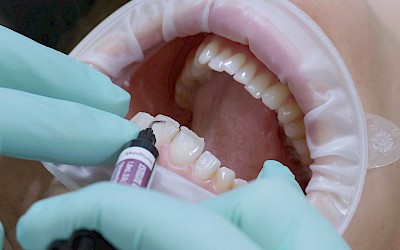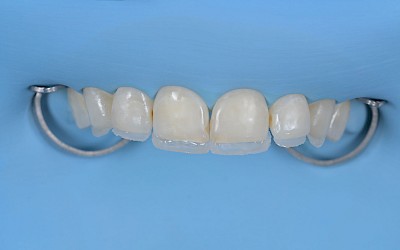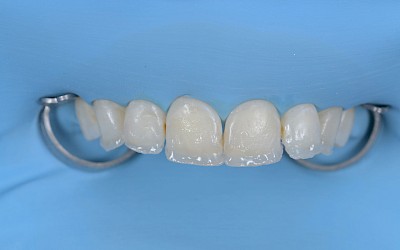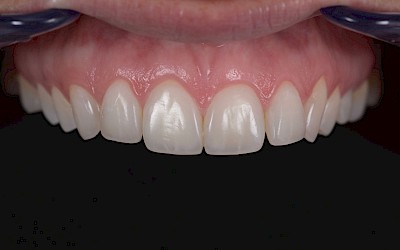Achieving 'More Dental Show' with Advanced Composite Veneers
A Patient-Centered, Minimally Invasive Approach to Restoring Self-Confidence and Natural Smile Aesthetics – by Freek Gols Linthorst
Introduction
A patient presented with a history of significant tooth wear caused by erosion and bruxism, resulting in shortened teeth and aesthetic concerns. She expressed dissatisfaction with the crowding in her upper anterior teeth and the discoloration of tooth 25 (Figure 1). Her primary request was for "more dental show" while ensuring the restorations retained the natural appearance of her teeth.
The treatment plan focused on restoring the natural proportions and esthetics of the anterior teeth while respecting their current alignment and accommodating future orthodontic correction. Tooth 25 was managed with an internal bleaching plan after restoring the front teeth to harmonize the overall smile. TOKUYAMA’S ESTELITE UNIVERSAL FLOW, ESTELITE ASTERIA, and ESTELITE COLOR were selected for their excellent handling properties, high polishability, and ability to achieve lifelike translucency and depth. These materials facilitated a minimally invasive approach that delivered precise and aesthetically pleasing results while addressing the patient's functional and cosmetic concerns.
The case report as video
To activate the YouTube video, you must agree to the marketing cookies.
Method
The treatment began with a digital smile design created using Apple’s Keynote software, allowing visualization of the planned outcome and helping the patient understand the proposed changes (Figure 2). After reviewing and approving the design, the process advanced to shade selection, ensuring the optimal match for the patient’s natural dentition. Once the shades were determined (Figure 3), the process moved forward to the mock-up phase.
To translate the digital design into the patient’s mouth, a quick mock-up was created using ESTELITE UNIVERSAL FLOW (Medium, shade A2) (Figure 4). The material’s medium viscosity ensured precise application, making it ideal for quickly visualizing the restorations. A putty index was fabricated from the mock-up to guide the layering process, and the flowable composite was subsequently removed.
After removal of the mock-up, the teeth were isolated using a rubber dam to ensure a clean and dry working environment. This step optimized the adhesion process and improved vision and control during the composite layering. Minimal tooth preparation was performed, which included creating a minimal bevel and using air abrasion with Aquacare (Velopex). These steps facilitated optimal composite integration and enhanced the bond strength (Figure 5).
The enamel of the teeth was etched using phosphoric acid for 30 seconds and thoroughly rinsed with water for 30 seconds. BOND FORCE II was then applied, following the manufacturer’s guidelines, to ensure optimal adhesion between the composite and the tooth surface.
The composite layering process was guided by principles of translucency and natural anatomy (Villarroel et al., 2011; Fahl, 2010; Fahl, 2015). A translucent palatal shell was created using ESTELITE ASTERIA TE shade to replicate the natural enamel’s light transmission (Figure 6). Next, ESTELITE ASTERIA A2B shade was applied to create dentin mamelons, adding depth and character to the restoration (Figure 7). Following this, ESTELITE ASTERIA A1B shade was used to create the incisal halo, enhancing the natural appearance.
To further refine the optical properties, ESTELITE COLOR Clear was applied between the dentin mamelons and the incisal halo (Figure 8). This was followed by the application of ESTELITE ASTERIA BL shade to create natural internal effects.
After the BL shade, little amounts of ESTELITE COLOR Blue mixed with ESTELITE COLOR Lavender tints were used to achieve the desired translucency shade in the area between the halo, mamelons, and internal effects (Figure 9). To reveal all the layering and effects, small amounts of the very transparent ESTELITE ASTERIA TE shade were applied over the incisal third of the restoration. Finally, ESTELITE ASTERIA WE shade was applied to complete the restorations, ensuring smooth transitions and a lifelike finish (Figure 10).
During the layering process, the TOKUYAMA BRUSH No.24 was used to shape and blend the composite seamlessly into the tooth surface before light curing each layer. This technique ensured a smooth integration of the composite and enhanced the natural appearance of the restoration.
The rubberdam was removed, and a new rubberdam was applied according to the “split dam approach”. Restorations were then finished and polished using a sequential approach, beginning with polishing discs to refine the surface. Paper cones and Arkansas stones were used to create primary, secondary, and tertiary anatomy, ensuring the restorations mimicked the natural contours and textures of the teeth (Figure 11). This process was completed using brownies and Occlubrush, achieving a high-gloss finish and optimizing both the durability and aesthetics of the restorations while ensuring seamless integration with the surrounding teeth (Figure 12).
During a second visit, the anterior restorations were slightly adjusted and polished again. Tooth 25 was prepared for internal bleaching to address its discoloration. This step was essential to harmonize the shade of the tooth with the newly restored esthetics of the anterior teeth, achieving a cohesive and balanced smile (Figure 13&14).
Conclusion
This case highlights the successful use of ESTELITE ASTERIA and ESTELITE COLOR to create highly aesthetic and functional composite restorations. The unique spherical fillers of ESTELITE ASTERIA contribute to its exceptional polishability, ensuring that a high-gloss finish is easily achievable with proper finishing and polishing techniques. These fillers allow for a smooth surface and light reflection properties that closely mimic natural enamel, further enhancing the aesthetic integration of the restorations.
The incorporation of modern materials and techniques allowed for a minimally invasive approach, preserving the natural tooth structure while addressing the patient’s concerns about tooth wear and aesthetics. The restorations have provided the patient with a functional and aesthetic foundation, preparing her for orthodontic treatment as the final step to achieving her beautiful smile.
The patient was highly satisfied with the results, noting the natural appearance and improved confidence in her smile. This case demonstrates how the advanced properties of ESTELITE ASTERIA, combined with careful planning and attention to detail, can achieve predictable and outstanding outcomes in composite veneer restorations.
References
- Villarroel M, Fahl N Jr, De Sousa AM, De Oliveira OB Jr. Direct esthetic restorations based on translucency and opacity of composite resins. Oper Dent. 2011;36(6):593-602. doi:10.2341/10-090-L
- Fahl N Jr. Mastering composite artistry to create anterior masterpieces: Part 1. J Esthet Restor Dent. 2010;22(4):219-234. doi:10.1111/j.1708-8240.2010.00356.x
- Fahl N Jr. A polychromatic composite layering approach for solving a complex class IV/direct veneer-restoration: Part 2. J Esthet Restor Dent. 2015;27(3):145-155. doi:10.1111/jerd.12178

Author:
Freek Gols Linthorst (MSc)
Dentist specializing in aesthetic and restorative dentistry. Co-owner of ACCT (Amsterdam Center for Cosmetic Dentistry) and co-founder of the Dutch educational initiative Karma Dentistry. He lectures internationally and combines his passion for art with dentistry.


















